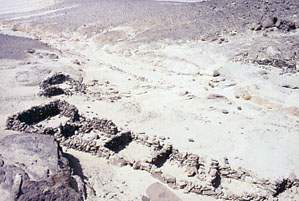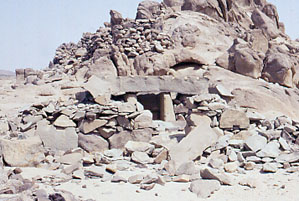|
Apart from a small shrine and a few huts, the settlement
at Fatrieh al-Baida comprises this row of well preserved rooms:
|
|
The shrine at Fatireh al-Baida is built from a few
large slabs of stone quarried nearby and only roughly finished:
|
|
|
|
|

|
|

|
|
|
|
|
|
|
|
|
Objective of visit:
|
|
To draw a measured plan of the site and study the surface
remains (including the ceramic finds). |
|
Date of visit:
|
|
- August 1997 |
|
Fellow visitors:
|
|
Prof.Dr. Steve Sidebotham (University of Delaware). |
| Results: |
|
A survey was performed using the Global Positioning System,
a theodolite and steel tape measures. Off-site assistance was given by
pottery expert Dr. Roberta Tomber (Museum of London). No excavations took
place. A full publication of this site is pending. |
| Approximate position and date
of the site: |
|
Fatireh al-Baida is in the northern part of the Egyptian
Eastern desert, north of the Qena-Safaga asphalt road, west of the Mons
Claudianus and Mons Porphyrites area. Surface pottery dated to the Roman
period (ca. 30 - 600 AD). |
| Short description of the site: |
|
Fatireh al-Baida was probably a stop on the ancient road
from the stone quarries in the Mons Claudianus and Mons Porphyrites area
to the Nile, even though the lay-out is not typical. There is a small stone
excavation area nearby and the settlement comprises a small shrine and
a number of huts. |
| Additional remarks: |
|
Judging by the size as well as the lay-out of the remaining
buildings and the absence of a fortified cistern or well, Fatireh al-Baida
was not af major importance to the ancient traffic but more likely served
a religious function. Our work was sponsored by the University of Delaware
and private donors. |
| HOME |
|
|
 |
|
|